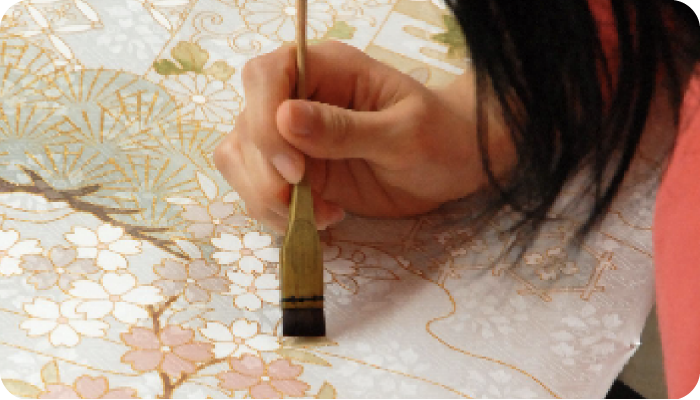Column Articles
What tools are used in Rakugo?folding fanand tenugui, and tools specific to Kamigata Rakugo
Rakugo is a traditional Japanese performing art in which storytellers entertain their audiences with satire and humor. The charm of rakugo lies not only in its skillful storytelling, but also in its use of unique tools. In this issue, we will introduce some of the tools used in rakugo to make it easier for rakugo beginners to understand. We will also touch on the props used in Kamigata Rakugo, so if you are interested in learning more about the world of Rakugo, please take a look at this article.
For more information, click here.
Published on June 22, 2023
What is the difference between "Noh" and "Kyogen"? Comparison of features and history at a glance
Noh" and "Kyogen," both traditional Japanese performing arts, are known for being performed on a Noh stage depicting a large pine tree, and have many similarities. What exactly are the differences between Noh and Kyogen? When viewing traditional performing arts, it is important to keep in mind the differences and highlights of both in advance.
This article provides basic knowledge about the differences between Noh and Kyogen. If you are interested in Japanese traditional performing arts, or if you are planning to see Noh or Kyogen, please read this article for reference.
For more information, click here.
Published on June 22, 2023
Deepen your knowledge of events unique to Japan|List of traditional and annual events
Japan has a variety of traditional events that are not found in other countries. Because of the four seasons of spring, summer, fall, and winter, many events and customs are unique to each season. In recent years, it is not uncommon for events that originated overseas to evolve into a uniquely Japanese style and take root in Japanese culture.
Here, we will introduce such Japanese-only events by season. We will also tell you about traditional events held at milestones in life. Let's take a fresh look at events that are familiar to Japanese people's lives.
For more information, click here.
Published on June 22, 2023
What is the true meaning of Setsubun? The Meaning of Mamemaki, How to Do it, and What to Eat
Setsubun is one of Japan's traditional events, and is now2month of May (the first day of the year)3Setsubun is one of Japan's traditional events, and is usually held on the first day of the month. Nowadays, the image of Setsubun as an event to drive away evil spirits by throwing beans (mame-maki) and eating ehomaki (rolls wrapped in eho-maki) is becoming more and more common. However, few people may know the original meaning of Setsubun. In fact, Setsubun is also related to "Nijushisekki," which refers to the turning points of the four seasons. In this issue, we will introduce the original meaning of Setsubun, the origin of Mamemaki (bean-throwing ceremony), and trivia about the event food eaten on Setsubun.For more information, click here.
Published on June 22, 2023
What is Ebisu-ko? When it takes place, its origin, and a nationally famous festival
Ebisu-ko" is a festival to worship Ebisu-sama. Ebisu-sama is one of the gods of Japan and is famous for being included in the seven gods of good fortune. You have probably seen him somewhere with a fishing rod in his hand, holding a large fish. He is believed by fishermen and farmers to bring bountiful catches, and is also believed by merchants as a god of prosperity. It is also believed in by merchants as a god of prosperity.
In this article, we will explain "Ebisu-ko," an event related to Ebisu-sama. Please read on as we introduce the basics of Yebisu-ko and famous Yebisu-ko in Japan.
Published on June 22, 2023
What to bring to a tea ceremony? What tools are needed for the tea ceremony and what is useful to have?
The tea ceremony is a traditional Japanese ritual. Many people are attracted by the beauty of the tea utensils and the manners of the tea ceremony, and many are interested in it. If you are invited to a tea ceremony party, what preparations should you make? When attending a tea ceremony, you should have the necessary utensils in plenty of time.
Here, for those who attend a tea ceremony tea party, we will introduce the basic items to bring and what is useful to have. We also explain what to wear at the tea ceremony, so please use this information to help you prepare for the day of the event.
For more information, click here.
Published on May 22, 2023
What is a Rakugo Yose? Basic knowledge and manners beginners should know.
In recent years, rakugo has become popular among young people due to the influence of popular manga and TV dramas, etc. While enjoying rakugo on CD or video is fine, it goes without saying that there is a special charm in a "yose," where you can enjoy a live performance by a rakugo performer or comedian. However, for beginners of Rakugo, Yose is an unknown world. There are probably many points of concern, such as how to buy tickets and etiquette. In this issue, we will introduce basic knowledge about Yose, etiquette and how to enjoy Rakugo for beginners.
For more information, click here.
Published on May 22, 2023
What to wear to a Sumo match? How to choose what to wear and what to bring
Sumo, the national sport of Japan, is a traditional sport with a long history. Although it is famous worldwide as a sport that symbolizes Japan, surprisingly few people have actually been to a sumo match. The appeal of watching a sumo match lies in the intensity that cannot be experienced live on TV, such as the fiercely competitive clashes between rikishi wearing mawashi (a ceremonial kimono) and the atmosphere in the venue filled with excitement. However, many people may be at a loss as to what to wear when they go to watch a sumo match. In this issue, we will introduce the manner in which to dress for a sumo match, what to bring that is useful, and how to enjoy the event.
For more information, click here.
Published on May 22, 2023
Manners of Tea Ceremony|How to dress, seating order, how to drink tea and eat sweets?
The tea ceremony is a traditional Japanese ritual in which the host entertains guests and serves tea. It is also called "chanoyu. Sen no Rikyu, a tea master active from the Warring States Period to the Azuchi-Momoyama Period, brought the tea ceremony to its peak. Today, there are several schools of tea ceremony, such as Omotesenke, Urasenke, and Mushanokoji Senke, and the spirit of the tea ceremony has been passed down to the present day.
If you are invited to a tea ceremony party, we recommend that you check the basic etiquette. Here, we will introduce the tea ceremony attire, seating order, and how to receive tea and sweets.
For more information, click here.
Published on May 22, 2023
What tools do you need for chess? The essentials and what can enhance the atmosphere of the game if you have them.
Shogi, a traditional Japanese game of chess, is a game of beauty that can be felt from the tools used in the game. When you see a professional player playing Shogi, you may think, "I want to play Shogi with real Shogi tools too! You may feel a longing to play Shogi with authentic tools. In this article, we will introduce tools necessary for playing Shogi and tools that enhance the atmosphere of a game. If you are just starting to play Shogi or if you want to enjoy the hobby even more, please read this article for reference.
For more information, click here.
Published on May 22, 2023
Shogi Etiquette│Precautions and Things Spectators Should Remember When Playing Shogi
In a game of Shogi, apart from the rules of the game, there are also rules of etiquette to ensure that both players are comfortable playing the game. In recent years, it has become easy to play Shogi online, and some people may not have many opportunities to meet their opponents face to face. However, if you are interested in participating in Shogi tournaments or social events, we recommend that you learn Shogi etiquette as well.
Shogi can only be played with a partner. To ensure a smooth game and friendly competition, it is important to learn the basic manners of Shogi. In this article, we will explain the manners you should know while playing or watching a game of Shogi.
For more information, click here.
Published on May 22, 2023
sandalwoodfolding fanHow do you tell the difference between real and fake sandalwood? Price and fragrance are the key factors.
Sandalwood gives off a unique sweet and gentle fragrance every time you look upfolding fan. The beauty of the openwork carving that makes the most of the wood's texture is also attractive.folding fanMany people may be longing to have a real sandalwood someday. Many people seek sandalwoodfolding fanHowever, since there are counterfeit sandalwood products on the market that are made of materials other than sandalwood, you need to be somewhat careful when purchasing sandalwood. This article describes such sandalwoodfolding fanand how to tell the difference between genuine and fake sandalwood. Genuine sandalwoodfolding fanand how to check the characteristics of genuine sandalwood to help you shop for the right one.
For more information, click here.
Published on April 26, 2023
The Appeal and History of Uchiwa as a Traditional Craft|Basic Knowledge of Japan's Three Major Uchiwa Crafts
What are the characteristics of uchiwa that have been traditionally made in each region? This article introduces the production areas of Uchiwa that have continued in Japan since ancient times and the charm of each type of Uchiwa.
Click here for details.
Published on April 26, 2023
17 Stylish Fans! Never fails.folding fanHow to choose a [Men's/Women's]!
The shape of a fan has the meaning of "spreading out and flourishing.folding fanis considered auspicious in Japan because it forms a shape that spreads out when unfolded. Fashionablefolding fanis recommended not only for daily use but also as a gift. They are a standard celebratory gift for kanreki celebrations and Respect-for-Senior-Citizens Day, but recently they are also gaining popularity as birthday presents and tasteful gifts for Mother's Day and Father's Day. In this issue, we will introduce stylish men's and women'sfolding fanand never-fail gifts.folding fanHere are some tips on how to choose the right one for you.
For more information, click here.
Published on April 26, 2023
Fan (folding fan) is good luck? Why and what to keep in mind when giving it as a gift.
folding fanis famous in Japan as an item of good luck. at festivals, celebrations, and other auspicious occasions.folding fanYou have probably seen them used in festivals, celebrations, and other occasions of congratulation. It is a good-luck itemfolding fanare also appreciated in gift-giving occasions. For gifts for family members or those who have taken care of youfolding fanWhy not choose a In this article,folding fanWe will tell you why it is considered to be a good omen. We will also tell you the points to keep in mind when making a gift, so please take a look at it.
For more information, click here.
Published on April 26, 2023
History of Uchiwa|Changes in usage and the three major types of Uchiwa in Japan
The sight of people fanning themselves with uchiwa fans to cool off has become a summer tradition. They are also popular as an item to add color to summer kimonos and yukata kimonos. What is the history of uchiwa fans before they took root in Japanese life? This article explains how Uchiwa originated in Japan and how their use has changed over the years. We will also introduce some historical uchiwa, such as the three most famous uchiwa in Japan. Please read this article to further enjoy the familiar Uchiwa.
Published on April 3, 2023
Recommended for gift givingfolding fan3Selection|Meanings, types, and tips on how to choose the right gift.
The key to choosing a gift for birthdays, anniversaries, and other celebratory occasions is to choose a gift that will make the recipient happy. If you can convey your feelings for the recipient and your congratulations, the gift will be more memorable. If you want to give a stylish gift for your loved one's anniversary,folding fanHow about a gift of Since ancient times,folding fanhas been a staple of gift-giving as an item of good luck. This time,folding fanand the meaning behind giving it as a gift, points on how to choose it, and gift recommendations.folding fanand more.
For more information, click here.
Published on April 3, 2023
folding fanNames of the various parts of the|Explanation of basic knowledge such as structure and main types
folding fanis a tool used to cool off during the hot and humid season by blowing air through a fan.round fan(The uchiwa has its roots in China, where it was first used as a portablefolding fanIt is said that the idea of making the fan in a portable form was invented in Japan. It used to be called a hiwogi (Japanese cypress fan), which was made by stacking bundles of wood. In Japan, they have been made since the Nara and Heian periods.folding fanThe structure of hiwogi fans has remained largely unchanged since the Nara and Heian periods. The fact that it is basically made with several to several dozen "fan bones" and a "fan surface" is said to be the same no matter what kind of fan is used.folding fanThe same is true no matter what the age of the fan is. This time, we would like to introduce you to a fan that is loved by many people all over the world.folding fanThis time, we would like to introduce the names and types of each part of the fan, which has many fans and is loved by people all over the world.
For more information, click here.
Published on April 3, 2023
folding fanWhat is the proper way to store a How to use and maintain it to make it last longer
When you want to add flair to your fashion or cool off during the hot season,folding fanYou may be a fan of the "K" series. If you are looking for a way to extend the life of your favoritefolding fanIt would be ideal if you could continue to use them indefinitely. However, it would be ideal if you could continue to use it forever,folding fanis basically a consumable item, the same item cannot be used forever. It is difficult to avoid deterioration over time if they are used for a long time.
Suchfolding fanis important to use and store them in a daily manner to keep them in use as long as possible. In an appropriate mannerfolding fanand care for your preciousfolding fanand make it last as long as possible. In this article,folding fanwill introduce the storage methods that you should keep in mind if you have a Let's go over it again to tell you how to use and maintain it.
For more information, click here.
Published on April 3, 2023
Luxuryfolding fanWhat is the difference between Characteristics, how to tell them apart, and recommended products.
Small and portablefolding fancan be used not only to match a cool yukata or kimono, but also for everyday use to keep cool. In recent years, they are available at reasonable stores and in a variety of price ranges. If you are using it as a fashion item or giving it as a gift to a loved one, it is a luxury and fashionable design.folding fanwith a stylish design. So, in this issue, we will introduce a selection of high-endfolding fanfeatures, points on how to choose, and recommended products.
For more information, click here.
Published on March 28, 2023
What is Tousenkyo? Basic playing and throwing tips
Tosenkyo is a traditional Japanese game,folding fanThe beauty of throwing a fan is the main attraction of Tousenkyo. Although you may have an image of it as a maiko's tatami room game, in fact, there are many schools and groups, and it is so popular that tossing contests are held. Recently, events have been held for those who are new to the art of Tousenkyo, where they can experience it for themselves. Since many of the matches are played in kimonos, it would be even more fun to play in kimono. This article explains how to play Tousenkyo.
For more information, click here.
Published on March 28, 2023
The meaning of Suehiro, correct usage to keep in mind, and manners to be aware of.
In Japan, a shape that spreads out toward the end is called "suehiro" and is considered auspicious. For example, the Chinese numeral "8" is an example of "suehigawari. Similarly, the shape of a fan spreading out is also considered to be "suehigawari,folding fanhas long been used as a lucky charm. In this issue, we will introduce the following items used for celebratory occasions.folding fanThis time, we will tell you about the "Suehiro (congratulatory fan)" used in celebrations. We will also explain the meaning behind Suehiro, its correct usage, and manners for celebrations.
Published on March 28, 2023
Basic Knowledge of Congratulatory Fans|Main Types, Proper Usage, and 6 Popular Congratulatory Fans
folding fanShugi fans have long been considered lucky charms in Japan and have been used on festive occasions. It is called "Shugi-fan (congratulatory fan)" at weddings and other celebratory occasions.folding fanis used as a small accessory. If you are wearing a formal kimono, please prepare a congratulatory fan as well. This article describes the characteristics of the fan and the generalfolding fanand the manner in which it should be used at festive occasions. In addition, a variety offolding fanof long-established stores that handleIbasenWe hope you will find it useful in preparing for your celebration.
For more information, click here.
Published on March 28, 2023
Fan ...folding fan・round fanWhat is the difference between History of each and 6 recommended products
We are all familiar withfolding fanand ... andround fan. They are all known as tools used to create wind by fanning with the hands, but what exactly are the differences between them? In this article, we will discuss the difference between a fan, afolding fan・round fanand its history. In addition, we will discuss the long-establishedIbasenrecommends the fan andfolding fan・round fanWe will introduce six products of the
For more information, click here.
Published on Feb 6, 2023
folding fanMain types of|Classification by material, use, origin, size, and correct usage
Used in a wide range of situations from daily life to lessons and celebrationsfolding fanIt is used in a wide range of situations from daily life to lessons and celebrations. Suchfolding fanare many different types. In recent years, in addition to using them yourself, they have been given as gifts and souvenirs tofolding fanas gifts, so we would like to check how to choose the right one for you. In this article,folding fanThis article explains the different types of materials, uses, production areas, sizes, and patterns (designs) that you should keep in mind when purchasing
For more information, click here.
Published on Feb 6, 2023
folding fanの贈り物に込められた意味|おすすめのプレゼントシーンと注意点
On occasions when you want to congratulate or express your gratitude to a loved one, you want to choose a wonderful gift that will remain in your heart. If you are at a loss to choose a gift for such a congratulatory occasion, please refer to the following list of gifts for gift-giving.folding fanfor gift-giving. Easy to carry and convenient to use in daily lifefolding fanhas also been regarded as a good-luck item since ancient times. In this article, we will discuss thefolding fangift, its meaning, recommended gift-giving occasions, and points to keep in mind when giving a gift.
For more information, click here.
Published on February 6, 2023
folding fanUntil the
「folding fanThe process pf making a fan NihonbashiIbasen14min 9sec No sound Edo fanThe process of making a fan Nihonbashi is shown in an easy-to-understand video.
July 6, 2020
Good.folding fanHow to tell the difference between
These days there are many different types offolding fanare sold in the market.folding fanare mostly made by hand and are crafts that express the skills of each individual craftsman. If used carefully, they will last for many years.
For more information, click here.
Published on July 6, 2020
round fanandfolding fanHistory of
In the ancient Takamatsuzuka burial mound, a noble lady holds up a large round wooden object sewn with lacquer on a stick about 80 cm long.round fanThe object looks like around fanThe "∗" part was sliced and folded into a foldablefolding fanThe beginning of the
Published on July 6, 2020



